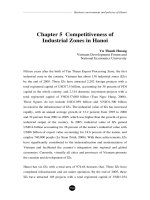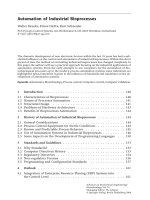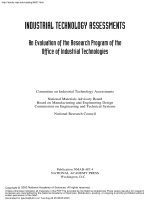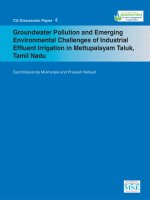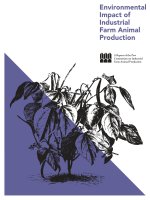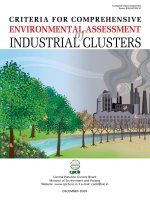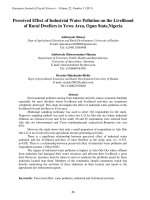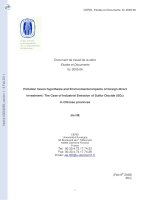biotreatment of industrial effluents
Bạn đang xem bản rút gọn của tài liệu. Xem và tải ngay bản đầy đủ của tài liệu tại đây (1.76 MB, 337 trang )
Biotreatment of
Industrial Effluents
This Page Intentionally Left Blank
Biotreatment of
Industrial Effluents
Mukesh Doble
Department of Biotechnology
I.I.T. Madras, Chennai,
India
and
Anil Kumar
Department of Chemistry
Sri Sathya Sai Institute of Higher Learning
(Deemed University)
Puttaparthi, Ananthapur District, Andhrapradesh,
India
AMSTERDAM • BOSTON • HEIDELBERG • LONDON
NEW YORK • OXFORD • PARIS • SAN DIEGO
SAN FRANCISCO • SINGAPORE • SYDNEY • TOKYO
Elsevier Butterworth–Heinemann
30 Corporate Drive, Suite 400, Burlington, MA 01803, USA
Linacre House, Jordan Hill, Oxford OX2 8DP, UK
Copyright © 2005, Elsevier Inc. All rights reserved.
No part of this publication may be reproduced, stored in a retrieval
system, or transmitted in any form or by any means, electronic, mechanical,
photocopying, recording, or otherwise, without the prior written permission
of the publisher.
Permissions may be sought directly from Elsevier’s Science & Technology
Rights Department in Oxford, UK: phone: (+44) 1865 843830, fax: (+44) 1865 853333,
e-mail: You may also complete your request on-line
via the Elsevier homepage (), by selecting “Customer Support”
and then “Obtaining Permissions.”
Recognizing the importance of preserving what has been written,
Elsevier prints its books on acid-free paper whenever
possible.
Library of Congress Cataloging-in-Publication Data
Application submitted
British Library Cataloguing-in-Publication Data
A catalogue record for this book is available from the British Library.
ISBN: 0-7506-7838-0
For information on all Elsevier Butterworth–Heinemann publications
visit our Web site at www.books.elsevier.com
Printed in the United States of America
050607080910 10987654321
To my parents
M.D.
To Bhagawan Sri Sathya Sai Baba
A.K.
This Page Intentionally Left Blank
Contents
Foreword ix
Preface xi
1. Introduction 1
2. Environmental Disasters 11
3. Aerobic and Anaerobic Bioreactors 19
4. Mathematical Models 39
5. Treatment of Waste from Organic Chemical Industries 55
6. Chlorinated Hydrocarbons and Aromatics, and Dioxins 65
7. Fluoride Removal 83
8. Biodegradation of Pesticides 89
9. Degradation of Polymers 101
10. Degradation of Dyes 111
11. Textile Effluent 123
12. Tannery Effluent 133
13. Treatment of Waste from Metal Processing and
Electrochemical Industries 145
14. Semiconductor Waste Treatment 157
vii
viii Contents
15. Waste from Nuclear Plants 169
16. Cyanide Waste 177
17. Treatment of Waste from Food and Dairy Industries 183
18. Sugar and Distillery Waste 189
19. Paper and Pulp 197
20. Paint Industries 209
21. Pharmaceuticals 217
22. Hospital Waste Treatment 225
23. Treatment of Waste from Explosives Industries 233
24. Petroleum Hydrocarbon Pollution 241
25. Biodesulfurization 255
26. Treatment of Solid Waste 267
27. Treatment of Municipal Waste 275
28. Groundwater Decontamination and Treatment 285
29. Denitrification 295
30. Gaseous Pollutants and Volatile Organics 301
Index 313
Foreword
Industrialization has led to growth of manufacturing industries and the
associated waste generated by them. Although green technologies that are
devoid of waste would be the ideal solution, it is certain that industries will
continue to generate effluent well into the foreseeable future. Environmen-
tal activism, stricter legislation, and improved awareness of environmental
issues on the part of industries have collectively led to a serious effort to iden-
tify best solutions to the problem of waste management. Biochemical means
of effluent treatment provide an attractive option that makes use of mild
biological conditions for the treatment of the waste and does not produce
new effluents. Moreover, identification of new microbial systems, includ-
ing extremophiles, has opened up new possibilities for such treatment, and
concerted efforts are being made in industries, academic institutions, and
research labs in the areas of bioremediation and biodegradation of waste.
This book covers the treatment of effluents from manufacturing indus-
tries as diverse as chemical and electronic. It also looks at other complex
wastes such as hospital waste. Comparisons are drawn between current
chemical methods and biochemical methods of treatment, including their
economics. Several of the biotreatment techniques are still in the infant stage
and need sustained research and development before they will be accepted as
viable technology options. The book also discusses succinctly the synergies
between various effluent treatment techniques, a particularly useful contri-
bution. I compliment the authors for the efforts they have made to bring out
this timely publication.
Dr Pushpito Ghosh
Director, Central Salt and Marine Research Institute
Bhavnagar, Gujarat, India
ix
This Page Intentionally Left Blank
Preface
As industrialization progressed rapidly in the Western world in the 20th cen-
tury, chemical, petrochemical, iron, and steel industries mushroomed at a
tremendous pace. The solid, liquid, and gaseous waste generated from these
industries was disposed in public places with very little thought given to its
treatment and detoxification. Local and federal governments were interested
in the economic progress such industries were bringing to their community
and were not aware of their short-term and long-term effects on the ecology
or on the health of the general public. In the late 1950s and early 1960s, evi-
dence mounted that waste that had been dumped affected the environment
and public health. In response, industries started treating their effluent, using
physical and chemical methods, before discharging it. Governments also laid
down standards for the quality of waste leaving an industry (U.S Environmen-
tal Protection Agency guidelines are found in the web
site). As the electronics and communication industries grew rapidly during
the 1970s and 1980s, highly toxic waste of a different kind was produced
and had to be disposed of. Metal recovery and leather processing industries
generated effluents with high concentrations of heavy metals and cyanides.
Industries in the West tried to shift their manufacturing base to underde-
veloped countries to avoid government regulations, but that was only a
short-term solution, because newer laws made manufacturers responsible
irrespective of the location of the manufacturing site. Although the physical
and chemical methods detoxified the waste, they created waste of a different
kind that also had to be disposed of in public places without causing dam-
age. Hence industries started adapting to biochemical treatment techniques
since they were mild and natural, and did not themselves generate waste.
Regulatory requirements have become stringent, and pressure from cit-
izen groups to improve the safety of waste that is being disposed of has
also increased, forcing manufacturing industries to spend more resources on
newer effluent treatment procedures. In addition, sites that had been con-
taminated at the beginning of the industrialization era have to be cleaned as
well due to pressure from local residents.
xi
xii Preface
Biochemical treatment, although offering several potential advantages,
cannot be used for treating all types of industrial effluents because many
of these treatment techniques are still in the research stage. Most of the
microorganisms are very specific to a particular pollutant, whereas a typical
effluent is a mixture of several pollutants and toxic chemicals. Hence a com-
bination of chemical/physical treatment followed by biochemical treatment
methods appears to be the best alternative today. There is plenty of scope
for scientists and engineers to undertake research both in the laboratory and
during technology development. Only a very small percentage of microor-
ganisms and bacteria have been tested, and there are still large amounts of
untapped organisms both in the land and in the ocean that could help in
degrading many of the recalcitrant wastes.
In the meantime, industries are carrying out research to recycle waste
streams and solvents in order to minimize the effluents that leave their
premises and achieve “zero discharge.” Also, new process technologies are
being developed with an eye to the concept of “atom efficiency”; namely,
developing processes in which the raw materials are completely converted
to the desired product without the formation of side or wasteful products.
The figure on the following page sums up the changes that have been taking
place both in manufacturing and in the field of effluent treatment during
the past fifty years. Industries have realized that minimizing and eliminat-
ing waste at its source is more effective than generating it and treating it
later. In the future, a combination of newer manufacturing and treatment
strategies will be the most effective and the least expensive. These newer
manufacturing strategies may include reducing the amount of solvent used,
recycling and recovery of solvents, optimum operating conditions to avoid
formation of side products and degraded products, and the use of chemicals
which are known to biodegrade.
The book covers treatment of most of the effluents from manufactur-
ing industries. Interestingly, industries that appear to be unrelated produce
effluents that are similar in nature. Simple aerobic activated sludge process
is used as a last step in most of the industrial units, since the unit is easy to
construct, maintain, and operate. Although several new bioreactor designs
are undergoing laboratory testing, full-scale technologies are slow to develop.
As will be shown in this book, the knowledge gained by treating effluents
from one industry has been extended to treat effluents from other industries.
At times mixing of effluents may have a beneficial effect, but at the same
time segregating and treating effluents may be easier. A colony of micro-
organisms brings in synergy, which is absent when single organisms are
used for treatment.
As I was teaching a course on Environmental Biotechnology to the
students in the class of 2005 at B. Tech. Industrial Center for Biotechnology,
Anna University, Chennai, India, I realized that there was no single source
that focused on biochemical treatment of all types of industrial effluents.
I undertook the writing of this book in response to that need, and I would
Preface xiii
Manufacturing
strategies
Effluent treatment
strategies
Waste
Government
pressure
Rapid industrialization
(organic & petro-
chemicals, pharma, iron
& steel)
Emergence of new industries
(electronic, computers,
leather, metal)
Zero
discharge
Atom
balance
Total replacement
of chemicals with
microbes/enzymes
/
natural resources
Indiscriminate
dumping of
untreated
waste
Chemical
treatment of
waste
Combined
chemical and
biochemical
treatment of
waste
Complete
biochemical
treatment of
waste
Future
Future
Replace a few chemical
steps with microbes during
manufacturin
g
xiv Preface
like to thank my students for sowing the seeds in my mind to take on such
a venture. This book can be used for the upper-level undergraduate as well
as graduate level courses. It is also well suited as a first point of reference for
practicing environmental engineers and researchers. Practitioners of envi-
ronmental biotechnology come from a wide variety of disciplines, including
agronomists, biochemists, microbiologists, botanists, chemical engineers,
geneticists, enzymologists, molecular biologists, protein technologists, pro-
cess chemists, and technologists. I hope this book has useful and relevant
information for all of them.
Mukesh Doble August 2004
CHAPTER 1
Introduction
Movement of Pollutants from the Source
A pollutant is defined as “a substance that occurs in the environment, at
least in part as a result of human activities, and has a deleterious effect on the
environment.” The term pollutant is a broad term that refers to a wide range
of compounds, from a superabundance of nutrients giving rise to enrichment
of ecosystems to toxic compounds that may be carcinogenic, mutagenic, or
teratogenic. Pollutants can be divided into two major groups, namely, those
that affect the physical environment and those that are directly toxic to
organisms, including human beings. The movement of pollutants and toxic
compounds through the environment is called pollution (Fig. 1-1) and is very
similar to the movement of energy and nutrients within the ecosystem or,
on a larger scale, through the biosphere.
Rapid industrialization in the twentieth century had led to the gener-
ation of vast amounts of gas, liquid, and solid waste that were introduced
into the environment without much thought by the manufacturers of that
waste. This has affected the ecosystem and has caused health problems for
the inhabitants residing near the factories. As people became more aware
of the toxic effects of this waste, as they saw the destruction of the ecosys-
tem due to the indiscriminate discharge of the pollutants, and as federal and
local laws imposed more stringent discharge norms, efforts were made to
treat these wastes so as to make them innocuous before discharge into pub-
lic systems. Initially, the treatment procedures were based on physical and
chemical methods, which proved to be inadequate and costly. Biochemical
methods, which have inherent advantages, are still in their early stages of
development.
Effluent Discharge — Points to Keep in Mind
Several points related to the discharge of pollutants into public waterways
or land have to be kept in mind, such as: local laws on discharge limits,
1
2 Biotreatment of Industrial Effluents
Land/soil
Surface
water
Groundwater
Air
Industrial pollution
• Chemicals
(solid/liquid/voc/gas)
• Radioactive
Municipal waste
(solid/liquid/gas)
Affect/alter
ecosystem
Landfill
Leaching
Evaporation
Seepage
Liquid/gas: treated/untreated effluent
discharge (accidenta
l/planned)
FIGURE 1-1. Movement of pollutants. VOC, volatile organic compound.
the effect of the pollutants on the ecosystem (short- and long-term data
may not be available), toxicity of the secondary metabolites, discharge
of secondary waste generated (such as sludge, inorganics, etc.), and the
impact of modifying the existing microorganism population in the soil or
water.
Different Treatment Procedures and Factors
Affecting Technology Selection
The treatment of solid, liquid, and gaseous pollution can be carried out either
in situ (i.e., at the contaminated site) or ex situ (i.e., removing the polluted
material, transporting it to another site or plant, treating it, and then bringing
it back to the site). Both approaches have several advantages and disadvan-
tages. The former is cost effective but could be slow and nonuniform. The
latter involves several steps and exposes the workers to the pollutants.
Physical, chemical, biological, and phytoremediation methods have
been attempted to destroy pollutants. The selection of the treatment technol-
ogy (Fig. 1-2) will depend on several factors, including cleanup time, maturity
of the technology, capital and operating costs, residual product toxicity after
treatment, local discharge norms, reliability of the process, ease of facil-
ity maintenance, company image, generation of volatile organic compounds
(VOCs), and treatment of halogenated compounds or explosives.
Introduction 3
Pollutant
• Solid/soil/sludge/
sediment
• Liquid
• Gas/vapor
Ex situ
In situ
Thermal
Chemical
Physical
Biochemical
Phytoremediation
Land fill /
containment
• Cleanup time
• Technology status (maturity)
• Operating cost
• Capital cost
• Residual product toxicity
• Process reliability
• Maintenance
• Company image
Factors affecting
process selection
Treatment
method
FIGURE 1-2. Selection of treatment technology.
In situ physical and chemical treatment techniques include:
• Chemical oxidation
• Electrokinetic separation
• Pneumatic or explosive fracturing of the soil
• Soil flushing using solvents, cosolvents, or surfactants
• Vapor extraction
• Thermal treatment using electric resistance, injecting hot air or steam, or
electromagnetic heating
• Containment by creating physical barrier
• Landfill
Ex situ physical and chemical treatment techniques include:
• Extraction with acid, alkali, solvent, or surfactants
• Mechanical separation such as magnetic, sieving, filtration, etc.
• Stripping using air or steam
• Chemical or thermal oxidation, reduction, or dehalogenation
• Incineration
4 Biotreatment of Industrial Effluents
• Absorption or adsorption of liquid or gaseous contaminants
• Separation of liquid contaminants by distillation, ion exchange, crystal-
lization, or membrane partition
An organic compound could be biodegraded by four different mechanisms,
namely, (a) aerobic oxidation of an organic primary growth substrate (e.g.,
natural organic material, hydrocarbon fuels, chlorobenzenes, and the less
oxidized chlorinated ethenes and ethanes); (b) anaerobic reduction, where
the organic compound serves as the electron acceptor (e.g., highly oxidized
chlorinated hydrocarbons, less chlorinated ethenes and ethanes such as
trichloroethane); (c) coupled oxidation and reduction of an organic compound
by a fermentation pathway; and (d) cometabolism of an organic compound,
which occurs when the degradation is catalyzed by an enzyme cofactor pro-
duced by microorganisms for some other purpose. The microbial processes
involved in biodegradation are linked to the extraction of chemical energy
for microbial growth, which comes from coupling the oxidation and the
reduction reactions.
Biological treatment technologies include:
• Enhanced bioremediation (enhancement achieved by addition of nitrate,
oxygen, or metabolites)
• Bioventing
• Bioaugmentation (organisms that have been specifically grown in the lab
on the contaminants)
• Biopiles
• Composting (windrow or static pile)
• Land farming
• Slurry phase bioreactors
• Biosorption
Phytoremediation techniques include:
• In situ phytoextraction/accumulation (removes toxins from the soil and
concentrates them in the harvestable part of the plant)
• In situ phytodegradation (plants and associated microbes degrade the
pollutants)
• In situ phytostabilization (the mobility of the pollutant is reduced through
chemical modification or immobilization)
• In situ phytovolatilization (volatilization of the pollutant into the atmo-
sphere)
• Enhanced rhizosphere biodegradation (plant roots absorb the pollutants)
Cost of phytoremediation has been estimated to be $25 to $100 per ton of
soil treatment and $0.60 to $6 per 1000 gallons for treatment of aqueous
waste streams. The cost of this remediation technique is estimated to be
half that of any other treatment. According to 1997 U.S. Environmental
Introduction 5
Protection Agency estimates, the cost of using phytoremediation in the form
of an alternative cover (vegetative cap) ranges from $10,000 to $30,000 per
acre, which is thought to be two- to fivefold less expensive than traditional
capping (Macek et al., 2000).
Environmental Engineering — An
Interdisciplinary Subject
Environmental engineering is an interdisciplinary subject encompassing
microbiology, biotechnology, chemical engineering, chemistry, analytical
chemistry, environmental chemistry, engineering design, and mechanical
engineering. Knowledge of atmospheric sciences, oceanography, geology,
and civil engineering is also essential.
Environmental engineering helps to maintain the quality of life through
the betterment of the environment. This means the development of suffi-
cient clean water supplies; the prevention of air, soil, river, lake, ocean, and
groundwater pollution; the maintenance of good air quality; and the reme-
diation by natural means of land and water contaminated with hazardous
chemicals. The use of “natural means” is an important prerequisite, else we
would be converting one type of pollution to another.
Various Chapters in the Book and How They Are
Interrelated
The five most polluting industries in the United States (1987 data) are iron
and steel, nonferrous metals, industrial chemicals, nonmetallic mineral
products, and pulp and paper. The polluting industries were classified on
the basis of the comprehensive index of emissions per unit of output. The
index includes conventional air, water, and heavy metals pollutants (Mani
and Wheeler, 1998). Table 1-1 compares the organic water pollution intensity
TABLE 1-1
Comparison of Organic Water Pollution Intensity
Index
Food 1.00
Pulp and paper 0.87
Chemicals 0.29
Textiles 0.26
Wood products 0.13
Metal products 0.08
Metal 0.03
Nonmetallic minerals 0.02
6 Biotreatment of Industrial Effluents
TABLE 1-2
Classification of Industries Based on Gaseous Pollution and Volatile Organic
Compounds
CO NO
x
SO
2
VOC
High Iron Industrial Metals Industrial
chemicals chemicals
Other chemicals Other chemicals
Petrol refinery Petrol refinery
Petrol Petrol
Medium Industrial Iron Industrial Metals
chemicals Metal chemicals Paper and pulp
Other chemicals Paper and pulp Other chemicals
Petrol refinery Petrol refinery
Petrol Petrol
Minerals
Paper and pulp
of various manufacturing sectors (Hettige et al., 1998). Table 1-2 groups the
various manufacturing industries based on the intensity of gaseous pollution
(Hettige et al., 1994; Rösner, 2003).
This book focuses on the biochemical treatment of gas, liquid, and
solid effluents from a wide range of manufacturing industries such as dye,
textile, paint, explosive, semiconductor, metal processing, pharmaceutical,
organic chemical, petroleum, food and dairy, paper and pulp, pesticide, sugar
and alcohol distillery, and polymer. Also discussed is treatment of solid
waste, including hospital and municipal waste; ground water decontami-
nation, including fluoride removal; denitrification and biodesulfurization
of petroleum; and cyanide degradation. Several biodegradation techniques
described in the book are still in the research and laboratory stage; in such
cases the physical and the chemical treatment techniques are being followed
by the relevant industries. Although the industries chosen in the book appear
to be disjointed, they all are interconnected, as shown in Fig. 1-3. For exam-
ple, effluents produced by organic chemical, pharmaceutical, pesticide, and
dye stuff industries all have several common characteristics. Tannery, elec-
trochemical, and semiconductor industries have metals in their effluents.
Dye chemicals are present in textile and tannery effluents. Effluents from the
food industry may have similar issues (Table 1-3 lists the effluent character-
istics of various agriculture-based industries). The book also briefly compares
the chemical and physical treatment procedures for these pollutants for the
sake of completeness. Both aerobic and anaerobic techniques and various
types of reactors that have been used for treatment are also discussed in
detail. This book can be used as a ready reference for physical, chemical,
and biochemical treatment of industrial pollutants as well as a source to
understand the mechanism of biodegradation of a variety of contaminants.
Introduction 7
Organic
chemicals
Pharma
Dyes
Paint
Chlorocompounds/
dioxin
Polymers
Fluoride
Hospital
waste
Leather
Cyanide
Metal
Semiconductor
Petroleum
Desulfurization
Radioactive
Paper & pulp
Sugar/
distillery
Food/
dairy
Reactors
Solid
Groundwater
Municipal
wastewater
Voc /
gases
Modeling
Denitrification
Pesticides
Explosives
FIGURE 1-3. Various industrial pollutions considered in the book. VOC, volatile organic compound.
8 Biotreatment of Industrial Effluents
TABLE 1-3
Comparison of Agricultural Industry Effluents
Effluent source COD (mg/L) BOD (mg/L)
Wool scouring effluent 45,000 17,500
Distillery 60,000 30,000
Dairy 1,800 900
Tannery 13,000 1,270
Textile 1,360 660
Kraft mill 620 226
COD, chemical oxygen demand; BOD, biological oxygen demand.
Major Findings
A few broad conclusions can be listed based on the survey carried out by the
authors:
• The majority of the treatment procedures followed by industries is still
based on physical and chemical methods.
• Biodegradation techniques are not yet broad based and have several
unsolved problems.
• Most of the wastewater from the industries studied is very complex and
cannot be treated by a single microorganism, so microbial colonies appear
to have good potential.
• Combined methods (physical, chemical, and biological or aerobic and
anaerobic) show good potential.
• Biofilters are a cost-effective and ubiquitous reactor for treating VOCs and
effluent gasses.
• Dynamic operation (as in sequential batch reactor) is able to achieve very
high degradation rates compared with steady state operation.
• Membrane reactors have very good potential, but their cost factor makes
them unpopular.
• White rot fungi (or any other extracellular organisms) are effective for
general purpose degradation.
• Biosorption using dead surface-modified microorganisms is an effective
technique for biodegradation and adsorption of metals from effluent
streams.
• The majority of the biodegradation studies reported in the literature have
been carried out with synthetic wastewater. These findings and con-
clusions have to be validated with real effluent, which may be more
complex.
Introduction 9
New Research Frontiers
A few of the areas that need focused study are:
• Degradation pathways
• Water-solvent interaction
• Use of biosurfactants for enhanced degradation
• Development of microorganisms tolerant to toxic effluents
• Development of microorganisms tolerant to principal and secondary
pollutants
• Identification of bacterial consortiums
• Transport of aromatic compounds through solid and liquid phases
• Engineering of bacteria to do various ecological tasks
• Determination of enzyme crystal structure
• Development of analytical tools
• Development of tools to follow the active organisms
• Identification of new microorganisms from the environment or from the
contaminated sites
• Identification of novel supports
• Long-term studies of the effects of pollutants on the ecology and the effects
of engineered organisms on the ecosphere
• Wetland ecosystems
References
Hettige, H., P. Martin, M. Singh, and D. Wheeler. 1994. IPPS: The Industrial Pollution
Projection System. Policy Research Working Paper, p. 1431.
Hettige, H., M. Mani, and D. Wheeler. 1998. Industrial Pollution in Economic Develop-
ment: Kuznets Revisited. World Bank Development Research Group Working Paper. January.
No. 1876.
Macek, T., M. Macková, and J. Ká. 2000. Exploitation of plants for the removal of organics in
environmental remediation. Biotech. Adv. 18(1):23–34.
Mani, M. and D. Wheeler. 1998. In Search of Pollution Havens? Dirty Industry in the World
Economy, 1960–95. J. Environ. Devel. 15(9):40–43.
Rösner, A. Pollution, Industrial Composition and Trade, Department of Economics Columbia
University, USA, 2003. < />This Page Intentionally Left Blank

